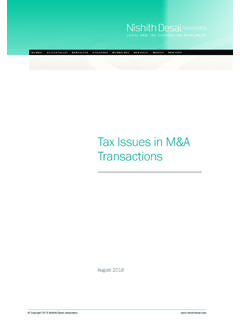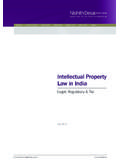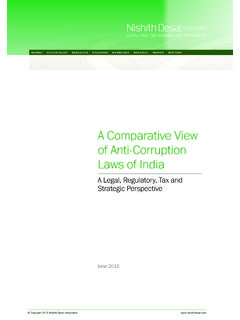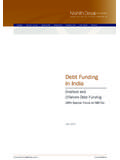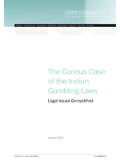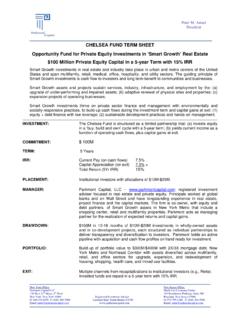Transcription of Private Equity and Private Debt Investments in India-3
1 MUMBAI SI LI C O N VALLE Y BAN G A LO RE SI N G A P O RE MUMBAI BKC NEW DELHI MUNICH NE W YO RK. Private Equity and Private debt Investments in india March 2018. Copyright 2018 Nishith Desai Associates Private Equity and Private debt Investments in india Private Equity and Private debt Investments in india March 2018. Nishith Desai Associates 2018. Private Equity and Private debt Investments in india Contents ABBREVIATIONS 01. 1. INTRODUCTION 03. I. Further liberalization of the foreign investment 03. II. Introduction of GAAR 04. III. Removal of long term capital gains exemption 04. IV. Tax neutrality on conversion of preference shares to Equity shares 05. V. Introduction of Thin Capitalization Norms 05. VI. Relaxations noti ed by the Competition Commission of india ( CCI ) 05. VII. Revised guidelines for the determination of the Place of Effective Management' ( POEM ) 06. VIII. Introduction of Bankruptcy Code 06. IX.
2 Amendments to the Tax Treaties with Mauritius, Singapore and Cyprus 06. 2. Private Equity Investments 07. I. FDI regime 07. II. FVCI regime 15. III. FPI regime 17. IV. NRI investment 21. 3. Private debt Investments 23. I. The FDI Route 25. II. FVCI regime 25. III. FPI regime 25. IV. CCD vs. NCD 27. 4. TAX CONSIDERATIONS AND EVOLVING STRUCTURES 28. I. Overview of Indian Taxation System 28. II. Speci c Tax Considerations for PE Investments 33. 5. EXITS FOR Private Equity AND Private debt Investments 41. I. IPO 41. II. Trade sale 41. III. Buy-back 41. IV. Depository Receipts( DRs ) 42. V. Externalisation 43. Nishith Desai Associates 2018. Private Equity and Private debt Investments in india 6. DISPUTE RESOLUTION 44. I. Impact of introduction of NCLT 45. II. Class action 46. ANNEXURE I 47. ANNEXURE II 51. ANNEXURE III 53. Nishith Desai Associates 2018. Private Equity and Private debt Investments in india Abbreviations Abbreviation Meaning / Full Form AAR Authority for Advanced Rulings ADR American Depository Receipt AIF Alternative investment Funds AIF Regulations SEBI (Alternative investment Funds) Regulations, 2012.
3 BITs Bilateral investment Treaties CA 1956 Companies Act 1956. CA 2013 Companies Act 2013. CBDT Central Board of Direct Taxes CCDs Compulsorily Convertible Debentures CCPS Compulsorily Convertible Preference Shares CLB Company Law Board Contract Act Indian Contract Act, 1872. DDP Designated Depository Participant DDT Dividend Distribution Tax DIPP Department of Industrial Policy and Promotion DTAA / Tax treaties Double Taxation Avoidance Agreements EBITDA Earnings Before Interest Tax Depreciation Ammortization ECB External Commercial Borrowing FDI Foreign Direct investment FDI Policy Foreign Direct investment Policy dated May 12, 2015. FEMA Foreign Exchange Management Act FIPB Foreign investment Promotion Board FII Foreign Institutional Investor FPI Foreign Portfolio Investor FPI Regulations SEBI (Foreign Portfolio investment ) Regulation 2014. Funds investment fund FVCI Foreign Venture Capital Investor FVCI Regulations SEBI (Foreign Venture Capital Investors) Regulations, 2000.
4 FY Financial Year GAAR General Anti-Avoidance Rules GDR Global Depository Receipt ICA International Commercial Arbitration ICDR Regulations SEBI (Issue of Capital and Disclosure Requirements) Regulations, 2009. IOSCO International Organization of Securities Commission IPO Initial Public Offering ITA Income Tax Act, 1961. Nishith Desai Associates 2018 1. Provided upon request only LTCG Long Term Capital Gains LoB Limitation on Bene ts LP Limited Partner MAT Minimum Alternate Tax NBFC Non-Banking Financial Companies NCD Non-Convertible Debenture NRI Non-Resident Indian OECD Organization for Economic Co-operation and Development OCD Optionally Convertible Debenture OCI Overseas Citizen of india OCRPS Optionally Convertible Redeemable Preference Share ODI Offshore Derivative Instruments OHC Offshore Holding Company PAN Permanent Account Number Press Note 8 Press note 8 of 2015 noti ed by the DIPP on July 30, 2015. Press Note 12 Press note 12 of 2015 noti ed by the DIPP on November 24, 2015.
5 P-Notes Participatory Notes PD Private debt PE Private Equity PIO Person of Indian Origin PIPE Private investment into Public Equity PIS Portfolio investment Scheme QFI Quali ed Foreign Investor R&W Insurance Representation and Warranties Insurance RBI Reserve Bank of india REITs Real Estate investment Trust RoE Return on Equity Rupees SEBI Securities and Exchange Board of india SGD Singapore Dollar STCG Short Term Capital Gains STT Securities Transaction Tax TISPRO Regulations Foreign Exchange Management (Transfer or Issue of Security by a Person Resident Outside india ) Regulations, 2000. TRC Tax Residency Certi cate UN United Nations USD United States Dollar 2 Nishith Desai Associates 2018. Private Equity and Private debt Investments in india 1. Introduction After recording it's highest ever PE Investments implemented its decision to abolish the in the year 2015, staggering to an amount of over FIPB by way of the introduction of Standard $ billion,1 india Inc.
6 Witnessed a slight dip Operating Procedure ( SOP ) for processing in PE activity in 2016 with PE infusion of $ the FDI proposals, issued by the DIPP on June billion spread across 620 deals. However, the 29, 2017. The focus of the SOP is to process such year 2017 surpassed the marvels of 2015, both in applications in a time bound manner so that terms of average deal size and overall deal value. the new regime for foreign Investments may The year 2017 recorded PE Investments worth $ be simpler in execution and expeditious in billion spread across 639 deals. disposal. The SOP has come into effect from the date of its publication. Following are some of transaction trends / issues that have gained significance in 2017: Furthermore, in November, 2017, the RBI issued the Foreign Exchange Management (Transfer or Issue of Security by a Person Resident Outside india ) Regulations, 2017 ( TISPRO. I. Further liberalization of Regulations ) that superseded the seventeen the foreign investment years old Foreign Exchange Management (Transfer or Issue of Security by a Person Since 2015, a large number of sectors, which Resident Outside india ) Regulations, 2000 ( Old were hitherto regulated, such as such defense TISPRO ).
7 Besides streamlining the foreign sector, construction-development sector, direct investment regime in india , the TISPRO. broadcasting industry, e-commerce, retail, Regulations has introduced several changes Private security agencies etc. have now been including overhauling of the foreign portfolio liberalized. The Government has been keen investment regime, liberalized investment on handing over the responsibility of granting regime for NRI / OCI and allowing foreign approvals to relevant sectoral regulators, instead direct investment in an Indian listed company. of the FIPB, for instance insurance, defense and The table below sets out some of the key changes financial services sector. The Government has introduced by the TISPRO Regulations and its impact on foreign Investments in india . Provisions Changes and analysis FDI vs. FPI While the meaning of FDI remains the same as earlier in case of Investments into an unlisted Indian company, however any Investments of 10% or more of the post issue paid-up Equity capital on a fully diluted basis of a listed Indian Any investment below 10% made by an entity registered with SEBI as a FPI or otherwise shall be regarded as foreign portfolio investment .
8 TISPRO. Regulations clari es that the total holding of an FPI may increase to 10%. or more of the total paid up Equity capital on a fully diluted basis or 10% or more of the paid up value of each series of capital instruments of a listed Indian company, however such investment shall then be re-classi ed as FDI subject to the guidelines to be speci ed by SEBI and the RBI in this regard. Till such time the RBI and SEBI issues the operational guidelines in this regard, the old regime under the Old TISPRO would continue to be applicable. 1. Available at: Nishith Desai Associates 2018 3. Provided upon request only Capital Instruments The term Capital' under the Old Regulations has been aligned with recent changes made to the FDI Policy and replaced with the term Capital Instruments' that means Equity shares, fully, compulsorily and mandatorily convertible debentures and preference shares and share warrants. It is clari ed that the partly paid shares or share warrant can be issued subject to 25% upfront payment of the consideration and the balance to be paid within 12 or 18 months from the date of such issue respectively.
9 It is further clari ed that the Capital Instruments may also be issued with an optionality clause subject to a minimum lock-in of 1 year (or as may be prescribed for the speci c sector, whichever is higher), however it has to be without any option or right to exit at an assured price. Acquisition of shares Under the Old TISPRO, the Capital Instruments (other than the Share by way of rights or Warrants) purchased by the person resident outside india as rights bonus issue issue or bonus issue shall be subject to the same conditions including restrictions in regard to repatriability as are applicable to the original shares against which right shares or debentures are issued. The TISPRO Regulations has eliminated the applicability of retrospective restrictions and has made such transfers subject to the conditions as are applicable at the time of such issue. However, in regard to repatriability restrictions, the position remains the same considering that an individual who is a person resident outside india at the time of exercising the right, which was issued to him when he was a resident in india , shall hold the Capital Instruments (other than the share warrants) so acquired on exercising the option on a non-repatriation basis.
10 Liberalization of NRI/ The TISPRO Regulations has relaxed the rules for NRIs / OCIs to be able to OCI Investments transfer the Capital Instruments to a person resident outside india by way Regime of sale or gift, provided that the investment made by the person resident outside india is on repatriation basis. In regards to the Investments by a person resident outside india under non-repatriation basis, while they have been allowed to transfer the Capital Instruments by way of sale without any approval, however transfer of Capital Instruments by way of gift would require prior approval of the RBI subject to satisfying several conditions including size of gift should not exceed 5% of the paid up capital of the Indian company, the value of the gift transferred in a year should not exceed rupee equivalent of USD 50,000 etc. II. Introduction of GAAR III. Removal of long term capital gains exemption After being deferred a few times, the GAAR has finally been introduced in Chapter X A of the The Government had reduced the LTCG on ITA.


